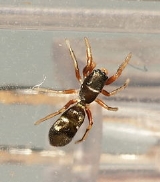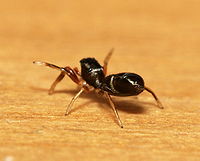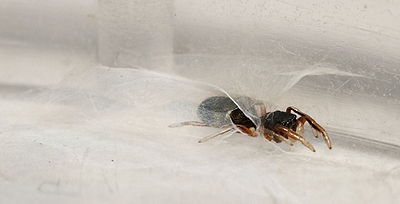
Synageles venator
Encyclopedia
Synageles venator is a species of ant-like
jumping spider
. It occurs in the Palearctic
region and Canada
, and is also found in North Africa. In Central Europe
it is the most common ant-like jumping spider.
 These spiders are virtually indistinguishable from ants, even for humans looking at them rather closely. They move rapidly like an ant, and even raise their second pair of legs like an ant's antenna
These spiders are virtually indistinguishable from ants, even for humans looking at them rather closely. They move rapidly like an ant, and even raise their second pair of legs like an ant's antenna
e. Hand-raised tits that had never come in contact with ants ate spiders of this species readily. However, after their first encounters with real ants, and the nauseating effect of their formic acid
, they refrained from eating S. venator.

Ant mimicry
Ant mimicry is mimicry of ants by other organisms. Ants are abundant all over the world, and insect predators that rely on vision to identify their prey such as birds and wasps normally avoid them, either because they are unpalatable, or aggressive. Thus some other arthropods mimic ants to escape...
jumping spider
Jumping spider
The jumping spider family contains more than 500 described genera and about 5,000 described species, making it the largest family of spiders with about 13% of all species. Jumping spiders have some of the best vision among invertebrates and use it in courtship, hunting and navigation...
. It occurs in the Palearctic
Palearctic
The Palearctic or Palaearctic is one of the eight ecozones dividing the Earth's surface.Physically, the Palearctic is the largest ecozone...
region and Canada
Canada
Canada is a North American country consisting of ten provinces and three territories. Located in the northern part of the continent, it extends from the Atlantic Ocean in the east to the Pacific Ocean in the west, and northward into the Arctic Ocean...
, and is also found in North Africa. In Central Europe
Central Europe
Central Europe or alternatively Middle Europe is a region of the European continent lying between the variously defined areas of Eastern and Western Europe...
it is the most common ant-like jumping spider.
Description
Female are about four millimeters long, males slightly smaller. They are similar to the jumping spider Leptorchestes berolinensis, but feature a white line on the back ouf their heads.Effect of mimicry

Antenna (biology)
Antennae in biology have historically been paired appendages used for sensing in arthropods. More recently, the term has also been applied to cilium structures present in most cell types of eukaryotes....
e. Hand-raised tits that had never come in contact with ants ate spiders of this species readily. However, after their first encounters with real ants, and the nauseating effect of their formic acid
Formic acid
Formic acid is the simplest carboxylic acid. Its chemical formula is HCOOH or HCO2H. It is an important intermediate in chemical synthesis and occurs naturally, most notably in the venom of bee and ant stings. In fact, its name comes from the Latin word for ant, formica, referring to its early...
, they refrained from eating S. venator.

External links
- Salticidae.org: Diagnostic drawings

